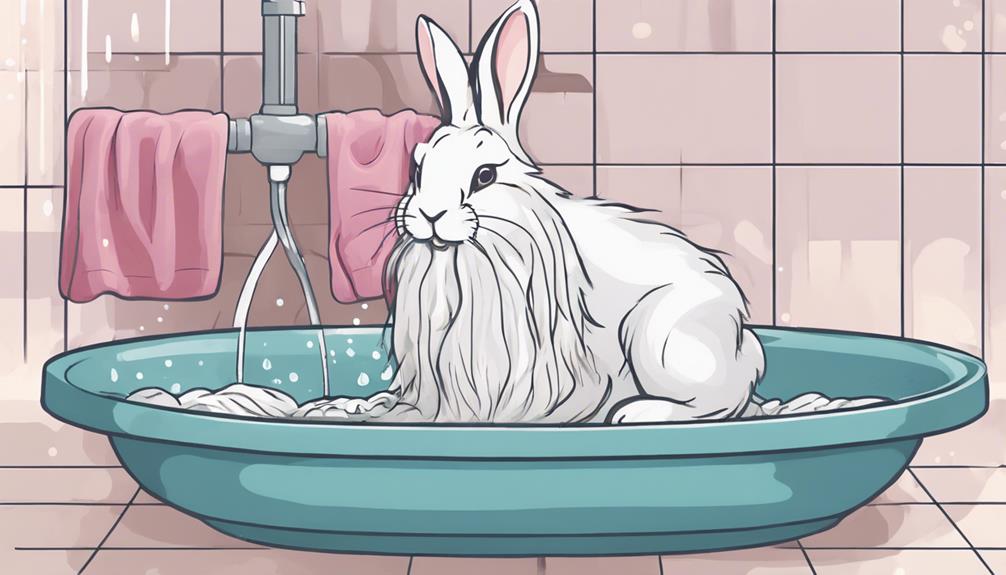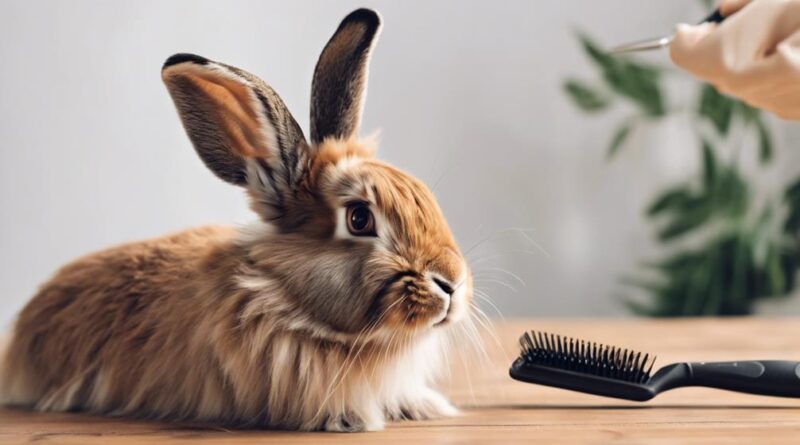Ultimate Guide to Grooming Long-Haired Rabbits
To groom your long-haired rabbit effectively, understand the coat types and their needs. Regular grooming prevents matting and health issues. Use suitable tools for your rabbit's coat. Create a calm grooming environment. Brush gently to maintain coat health. Trim hair safely for appearance. Combat smells by thorough drying. Establish a grooming routine for cleanliness. Keep nails trimmed for hygiene. Maintain ear hygiene to prevent infections. Seek professional advice when needed. For a comprehensive guide on grooming long-haired rabbits, focus on coat care essentials to ensure your pet's well-being and charm.
Understanding Long-Haired Rabbit Coat Types
When grooming long-haired rabbits, understanding the different coat types is crucial for maintaining their health and appearance. Long-haired rabbits can have various coat types, ranging from single coats to double coats. Understanding these distinctions will help you establish appropriate grooming schedules to prevent matting and maintain a healthy coat.
Long-haired rabbits experience seasonal coat changes, shedding more during spring and fall. This shedding can pose grooming challenges, as the excess fur can lead to matting if not addressed promptly. To combat this, consider grooming your rabbit more frequently during these times to manage shedding and prevent matting. Regular grooming not only keeps your rabbit looking neat but also helps in preventing health issues related to fur ingestion during self-grooming.
Single-coated rabbits have hair that's easier to maintain compared to double-coated ones. However, both types require regular grooming to prevent tangles and mats. Establishing a grooming routine based on your rabbit's coat type will help you manage shedding effectively. Pay close attention to areas like behind the ears, under the chin, and the lower back where mats tend to form more frequently.
Understanding your long-haired rabbit's coat type and the associated grooming requirements will ensure they stay healthy, comfortable, and looking their best year-round.
Essential Grooming Tools for Rabbits
Understanding the coat type of your long-haired rabbit will guide you in selecting the appropriate grooming tools necessary for maintaining their health and appearance. For long-haired rabbits, grooming frequency is crucial to prevent matting and tangling. Regular grooming, at least once a week, is recommended to keep their fur in good condition. During shedding season, which occurs about every three months, more frequent grooming may be necessary to manage the increased hair loss and prevent fur blockages in their digestive system.
To effectively groom your long-haired rabbit, you'll need a few essential tools. A slicker brush is excellent for removing loose fur and preventing mats. Combining a slicker brush with a wide-toothed comb can help detangle any knots gently. For stubborn mats, a mat splitter or mat rake can be handy tools to have in your grooming kit. Additionally, a pair of blunt-tipped scissors is essential for trimming any fur around their eyes or bottom to maintain cleanliness and prevent discomfort.
Investing in high-quality grooming tools specific to long-haired rabbits will make the grooming process more manageable and comfortable for both you and your furry friend. Proper tools won't only keep your rabbit looking their best but also contribute to their overall health and well-being.
Setting Up a Relaxing Grooming Environment
To create a soothing grooming experience for your long-haired rabbit, ensure the grooming environment is calm and free of distractions. This will help your rabbit feel more at ease during the grooming process.
Here are some key tips to set up a relaxing grooming environment:
- Creating a calming atmosphere:
- Choose a quiet room where you can groom your rabbit without interruptions.
- Play soft, soothing music or use white noise to create a calming ambiance.
- Ensure the room is at a comfortable temperature, neither too hot nor too cold.
- Dim the lights slightly to avoid any harsh lighting that could startle your rabbit.
- Proper handling techniques:
- Approach your rabbit gently and speak softly to reassure them.
- Use slow, deliberate movements to avoid startling your rabbit.
- Support your rabbit's body securely during grooming to prevent any sudden movements.
- Take breaks if your rabbit seems stressed, allowing them time to relax before continuing.
Brushing Techniques for Long Fur
For effective grooming of long fur on rabbits, mastering the right brushing techniques is crucial to maintain their coat's health and appearance. To prevent knots and control shedding, it's essential to use the correct tools and methods. Start by gently combing your rabbit's fur using a slicker brush or a wide-toothed comb. Work in small sections, ensuring you reach down to the skin to remove any tangles or loose fur. Pay special attention to areas like behind the ears, under the chin, and around the tail where mats tend to form.
Regular grooming not only prevents knots but also promotes coat health. Long-haired rabbits should be brushed at least 2-3 times a week to keep their fur in top condition. This frequency helps distribute natural oils, prevents matted fur, and reduces the amount of loose hair around your home. Additionally, brushing is a bonding activity that allows you to check your rabbit's skin for any abnormalities or parasites.
Trimming Your Rabbit's Hair Safely
To ensure proper grooming of your long-haired rabbit, mastering the skill of safely trimming their hair is vital for maintaining their overall coat health and appearance.
- Safety Precautions: Before trimming your rabbit's hair, make sure they're calm and comfortable to prevent sudden movements that could lead to accidental cuts.
- Choosing Suitable Scissors: Opt for small, sharp scissors with rounded tips to minimize the risk of injuring your rabbit during the trimming process.
- Proper Technique: When trimming, hold the fur between your fingers and carefully snip small amounts at a time to avoid cutting the skin underneath.
- Regular Inspections: Check your rabbit's fur frequently for any matting, tangles, or signs of discomfort that may require immediate attention.
Dealing With Matting and Tangles
When addressing matting and tangles in your long-haired rabbit's fur, meticulous care and patience are essential for effectively resolving these grooming challenges. Preventing matting is key to maintaining your rabbit's luxurious coat. Regular grooming sessions, using a slicker brush to remove loose fur and prevent tangling, can significantly reduce the chances of matting. Ensure you detangle your rabbit's fur gently, starting at the tips of the hair and working your way up towards the skin to prevent causing discomfort or pain.
Handling shedding is another crucial aspect of fur maintenance for long-haired rabbits. Brushing your rabbit frequently, especially during shedding seasons, helps remove loose fur before it has a chance to mat with the existing coat. Use a comb with wide teeth to work through any knots carefully. If you encounter a stubborn tangle, try using a small amount of cornstarch or specialized detangling spray to help loosen the knot without causing stress to your rabbit.
Regular maintenance of your rabbit's fur is essential to prevent matting and tangles. By incorporating these preventative measures and gentle handling techniques into your grooming routine, you can keep your long-haired rabbit's coat healthy and free from mats.
Bathing Tips for Long-Haired Rabbits

When tackling the grooming needs of your long-haired rabbit, maintaining proper bathing techniques is vital for the health and cleanliness of their luxurious coat. Here are some essential tips to help you keep your long-haired rabbit clean and healthy:
- Preventing skin issues: Long-haired rabbits are prone to skin problems if not cleaned regularly. Use a gentle rabbit-specific shampoo to prevent skin irritation and maintain a healthy coat.
- Seasonal considerations: Adjust the frequency of baths based on the season. In warmer months, your rabbit may need more frequent baths to prevent overheating and keep their fur clean. In colder seasons, reduce the bathing frequency to avoid stripping the coat of natural oils.
- Drying methods: After bathing your rabbit, ensure thorough drying to prevent moisture-related skin issues. Use a towel to gently pat dry their fur and consider using a hairdryer on a low, cool setting if your rabbit is comfortable with it.
- Combating smells: Long-haired rabbits can sometimes develop odors, especially in the hindquarters area. Regular baths can help combat smells, but be cautious not to over-bathe as it can lead to dry skin. Spot cleaning with a damp cloth between baths can also help manage odors effectively.
Maintaining Overall Rabbit Hygiene
Ensure your long-haired rabbit's overall hygiene by incorporating a regular grooming routine that focuses on cleanliness and health maintenance. Nail trimming is an essential part of maintaining your rabbit's hygiene. Overgrown nails can cause discomfort and even lead to health issues. Use a small animal nail clipper to carefully trim the nails, ensuring not to cut too close to the quick, which can cause bleeding. If you're unsure about how to trim your rabbit's nails, consult a veterinarian or a professional groomer for guidance.
Ears are another area that require attention for proper hygiene. Regular ear cleaning helps prevent infections and removes any buildup of dirt or wax. Gently wipe the outer area of the ears with a damp cloth or a specially formulated ear cleaner for rabbits. Avoid inserting anything into the ear canal to prevent injury. If you notice any redness, swelling, or unusual discharge in your rabbit's ears, seek veterinary advice promptly.
Frequently Asked Questions
Can Long-Haired Rabbits Participate in Rabbit Shows?
Long-haired rabbits can absolutely participate in rabbit shows! Grooming techniques are key for show success. Regular coat maintenance is crucial to keep your rabbit looking top-notch.
Show requirements often include well-groomed fur, trimmed nails, and a clean appearance. Proper show preparation involves practicing grooming routines to ensure your long-haired rabbit is show-ready.
How Often Should I Check My Rabbit's Ears for Cleanliness?
You should check your rabbit's ears for cleanliness at least once a week. Regular checks help prevent ear mites and maintain good ear hygiene.
To clean the ears, use a damp cloth or specialized ear cleaning solution recommended by your vet. Gently wipe the outer ear area, avoiding the ear canal.
If you notice any redness, discharge, or unusual odor, consult your veterinarian for proper ear health assessment and treatment.
Is It Safe to Use Human Hair Products on Rabbits?
Yes, using human hair products on rabbits is generally not safe. When it comes to rabbit grooming, it's crucial to use products specifically formulated for them to avoid any potential harm.
While human hair products may seem convenient, they can contain ingredients that are harmful to rabbits. Opt for alternative products designed for rabbit grooming to ensure their safety and well-being.
Can Long-Haired Rabbits Get Sunburned on Their Ears?
Yes, long-haired rabbits can get sunburned on their ears, affecting their health.
To provide sun protection, apply pet-safe sunscreen or provide shade.
When grooming, pay special attention to their ears, ensuring they're clean and free from tangles that could expose sensitive skin.
Incorporating proper grooming techniques and ear care into your routine will help prevent sunburn and maintain your rabbit's overall well-being.
What Are the Best Treats for Rewarding a Well-Groomed Rabbit?
For rewarding a well-groomed rabbit, the best treats are healthy snacks like fresh veggies or fruits. These treats not only serve as grooming rewards but also promote bonding between you and your bunny.
Incorporating grooming techniques during treat time can strengthen your relationship while keeping your long-haired rabbit happy and healthy. Remember, it's essential to choose treats that are safe and suitable for your furry friend's diet and well-being.
Conclusion
Now that you have mastered the art of grooming long-haired rabbits, you can ensure that your furry friend stays healthy and happy. Remember to regularly brush their fur, trim any overgrown areas, and keep an eye out for matting and tangles.
With the right tools and techniques, grooming your long-haired rabbit can be a relaxing bonding experience for both of you. Keep up with their hygiene routine to maintain their beautiful coat and overall well-being.
